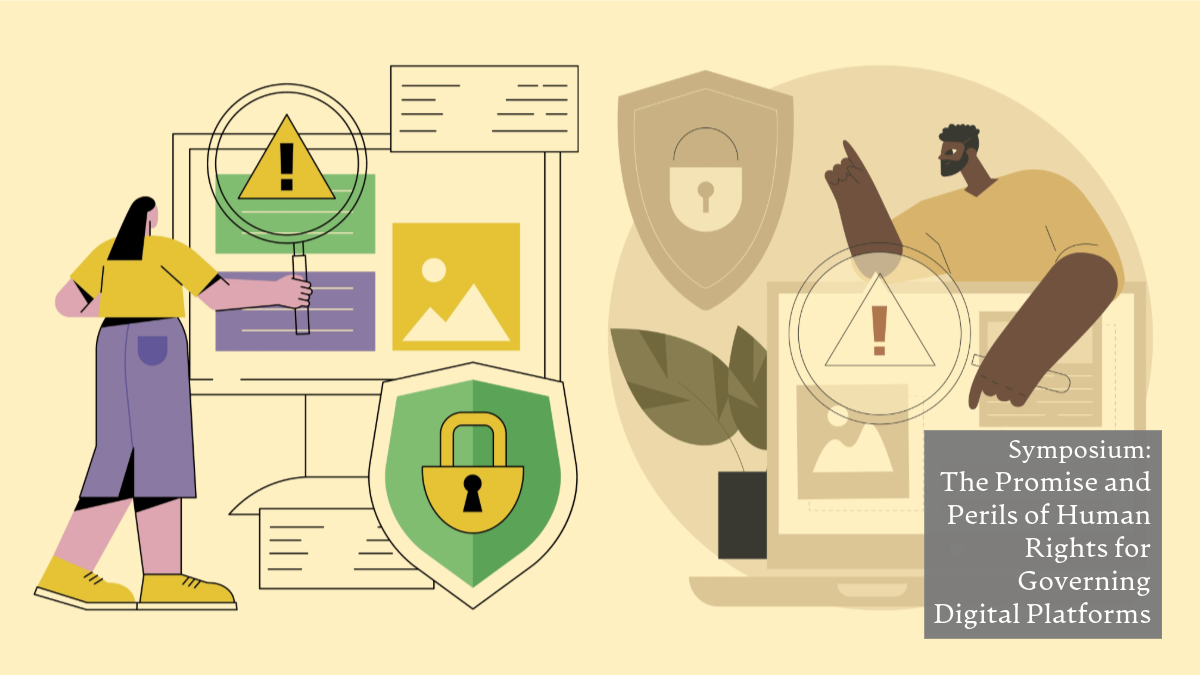The “Limits” of International Human Rights Law in Content Moderation: an Alternative Diagnosis
Stefania Di Stefano / Jun 21, 2024This essay is part of a symposium on the promise and perils of human rights for governing digital platforms. Read more from the series here; new posts will appear between June 18 - June 30, 2024.
International human rights law (IHRL) has emerged as a dominant discursive framework for articulating and addressing issues raised by digital platforms. Originally confined to regulating relationships between states and individuals, IHRL is today a relevant framework to regulate relationships between individuals and non-state actors, including businesses. The 2018 report of the UN Special Rapporteur on Freedom of Expression constituted a turning point in the historical trajectory of the relevance of IHRL in content moderation, elevating IHRL to the status of lingua franca in regulatory efforts to constrain the power of digital platforms, as well as in digital platforms’ own discourses, with companies adopting corporate human rights policies and/or creating oversight mechanisms.
Yet, despite its potential to offer a global language to articulate and address the questions raised by digital platforms, the “IHRL project” has its detractors, who argue, for example, that the adoption of this normative framework was not “inevitable”, that IHRL is inherently inadequate to address the unique challenges that these new actors and technologies pose, or that it constitutes a form of moralism.
Taking content moderation as a case study, I wish to question the fact that the critiques aimed at IHRL are diagnosing an inherent inadequacy of this framework in content moderation and offer an alternative diagnosis: the “limits” of IHRL identified by these critiques originate from and reflect a traditional approach to international law and are symptomatic not of the inherent inadequacy of IHRL to address these issues, but rather of instances of change in international law.
Traditional approaches as the origins of the critiques
Traditional approaches to international law are defined by their tendency to draw neat boundaries, aimed at including and excluding actors or norms in the international law realm. Lines are drawn between law and non-law, states and non-state actors, binding and non-binding law. The criticism aimed at IHRL in content moderation reflect this tendency to draw lines and can be understood as originating from a traditional understanding of international law: they are a result of “the way in which international law is traditionally thought about and taught”.
For example, the argument that IHRL is not suitable to address content moderation issues because its normative framework is designed to constrain governmental power and not corporate conduct seeks to draw a line between state and non-state actors, but also between binding and non-binding law. It is therefore suggested that, because IHRL treaties do not attach any obligations to corporate entities, international law does not (and cannot) impose any human rights obligations on these actors, and social media platforms cannot apply IHRL. This argument, which can be referred to as “the legal impossibility” argument, is not new.
Still, a competing argument can be made that “as a rule, human rights are to be respected by all persons, groups, and states, and that exceptional additional duties for the state have been explicitly articulated”. Indeed, companies are not directly bound by IHRL treaties, but, under the UN Guiding Principles on Business and Human Rights, these treaties are to be considered as an enumeration of the rights to be respected by businesses. Still, the argument that the current interpretation of the UNGPs in the context of content moderation “collapses the substance of states’ duties and businesses’ responsibilities” by calling on companies to look at treaties and other UN documents overlooks the fact that these constitute the starting point for defining those rights companies should respect. To comply with their responsibility to respect, companies must engage in an interpretive exercise, and it is only by looking at the text of these treaties and their authoritative interpretations that social media companies can devise rules and processes that respect human rights. It follows that, in principle, there is nothing that prevents actors other than states from relying on those treaties and even applying them.
It has been recognized that social media platforms do not have the same obligations as governments and that there might be differences on “how such rules [apply] in the context of a private company versus when they are being applied to a state”. The fact that these differences are yet to be sufficiently articulated does not necessarily translate into the fact that IHRL is an unsuitable framework to regulate social media platforms. The articulation of these rules is also hindered by a lack of transparency over content moderation processes. Moreover, while it is true that corporate responsibilities may differ from state duties, in some contexts they may also overlap: the fact that the UNGPs operate a distinction between these actors does not necessarily mean that the substantive measures to be implemented by one or the other must be different.
Another critique that is often made of IHRL is that the framework is too indeterminate to be able to offer any concrete answers to the challenges presented by content moderation. That IHRL does not offer clearcut answers to content moderation questions is not something unique to content moderation. As argued by Venzke, interpretation makes international law: as such, any development of normative standards applicable to content moderation (or any other issue) will be the result of interpretive acts made by participants in international law-making.
What IHRL offers is a language and a framework to articulate answers that would respect human rights. Examples of IHRL standards being expanded in time through interpretation include the lowering of the threshold for conduct amounting to torture and inhuman and degrading treatment, the increased protection of LGBT rights, that climate change-induced conditions that violate the right to life may trigger non-refoulement obligations. Perhaps one of the issues underlying the “indeterminacy” critique hides another critique, which questions the legitimacy of the actors engaging in interpreting IHRL in content moderation, including social media platforms or the Oversight Board, for example, who are not state actors.
A final criticism that is aimed at IHRL in content moderation relates to the use of sources: if on the one hand the reliance on IHRL treaties is contested because these instruments do not directly bind corporations, on the other hand the reliance on other standards emanating from human rights bodies is contested because these documents are not binding but constitute only persuasive authority. This critique reveals the longstanding concern with the “bindingness” of law: in one case, although the standards are considered “hard law”, they do not bind the relevant actor; in the other case, despite the standards being relevant for non-state actors, or even tailored to them, their legitimacy and relevance are questioned due to falling within the realm of 'soft law'. However, the adoption of a binary understanding of law prevents a thorough account of the “practices of all kinds of actors related to law and legal norms”. By understanding legality as a matter of degree instead, it is possible to “take seriously the ways in which this broader range of actors construe law and legal relations through their social practices”.
An alternative diagnosis
The common thread that these critiques share is that they diagnose deviations from international law as traditionally understood. This misdiagnosis finds its rationale in the attempt to pigeonhole these phenomena in predetermined international law categories. However, the difficulties linked to the ability to qualify these phenomena through traditional understandings of international law can in fact be symptomatic of instances of change in international law. As underscored by the legal scholar Nico Krisch, “[i]n many instances, international law is changing much more flexibly than the traditional picture leads us to believe.” Content moderation is a field where the symptoms of change he identifies are quite visible. Other actors, beyond states, actively participate in lawmaking and drive normative change, regardless of whether these standards are universally applicable across the discipline of international law or confined to an issue area. Legality is also not treated as binary: for example, a norm developed for content moderation by a UN Special Rapporteur, which would traditionally fall within “soft law,” is perceived as binding, or at least as highly authoritative, by other actors in the field. This shows how the law practiced by actors in a given field “may or may not correspond with doctrinal reconstructions of what the law is.”
An alternative diagnosis of the symptoms identified with respect to the application of IHRL in content moderation may therefore indicate that these deviations from the traditional understanding of international law could constitute the seeds of legal change: they could be a manifestation of “a paradigm shift in our understanding of the power and utility of human rights,” an attempt to “turn human rights on their heads and [the] realiz[ation] that while they have protected private power, they also contain the seeds for action against private power.” If this diagnosis is correct, then the treatment to be adopted is not an entire dismissal of IHRL as a framework to address issues raised by content moderation, but rather a deeper investigation and assessment of these manifestations of change and their processes.
Authors

